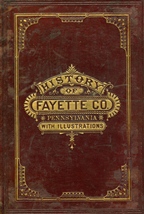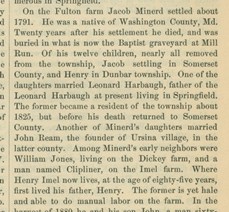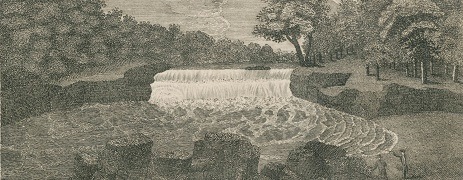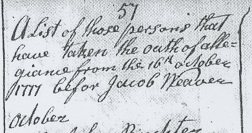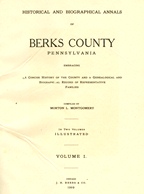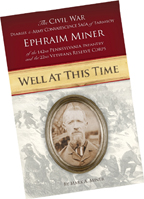
|
Jacob
Minerd Sr. |
|
Revolutionary War Veteran and Pennsylvania-German Pioneer |
 |
| Indian Creek
Baptist Church, Mill Run, PA |
Jacob and Maria Margaret (Nein) Minerd Sr., were our pioneer ancestors of Southwestern Pennsylvania who settled in Fayette/Somerset Counties, the epicenter of our family's explosive growth the past 200-plus years.
Jacob is acknowledged as a Revolutionary War patriot by the federal government's Department of Veterans Affairs and the prestigious Daughters of the American Revolution (DAR), and a standard issue military grave marker was dedicated in his memory at our national reunion in 2003.
To provide a sense of what the Minerds produced, they together bore 12 children, of whom eight are identified. At last count, those eight children had at least 87 grandchildren, 469 great-grandchildren and 1,344 great-great grandchildren, for a total of 1,912 lives, virtually all born before the year 1900. Today, their descendants and spouses number an estimated 75,000 or more, and are scattered all over the world.
Jacob was the son of German-Americans Friedrich and Eva (Weber) Meinert, who are believed to have migrated from Albany, NY to Oley Township, Berks County, PA in about 1730. Maria's parents were Casper and Barbara Neün, who were German immigrants who established their home in Oley.
The Minerds together produced a brood of a dozen children, of whom we know the identities of just eight -- John Minard Sr. (born 1766, of Harrison County, OH); Burket Minerd (born 1774, of Preston County, WV), Daniel Miner Sr. (born 1776, of Perry and Morrow Counties, OH), Frederick Miner Sr. (born 1777?, of Perry County, OH), Jacob Minerd Jr. (born 1780, of Somerset County, PA), Catharine Ream (born [?], whose husband founded the village of Ursina, Somerset County, PA), Martha Imel Harbaugh (born 1789, of Somerset County, PA); and Henry Minerd (born 1790, of Fayette County, PA).
Another daughter may have been Christina, known to have been born on Dec. 19, 1783 to parents "Jacob Meinhardt and wife Margreth" in Frederick, Frederick County, MD.
Jacob and Maria started married life in Oley Township, where their son Burket (or "Burkhard") was born and baptized in a Lutheran church. During the American Revolution, Jacob took an oath of allegiance, and served in the Berks County Militia, Captain Foch's Company, 3rd Class.
|
|
|
1882 History of Fayette County, Pennsylvania, with a substantial paragraph about Jacob and his "twelve children" |
During the war, Berks County's German community was a mixture of activism and pacifism. In fact, shortly after the war's inaugural battles, in Lexington and Concord, MA, Berks soldiers "were among the first troops to report to the newly appointed commander-in-chief, George Washington." Yet two years later, after the Declaration of Independence was signed, says Frantz and Pencak's 1998 book, Beyond Philadelphia, anyone who refused to support the war was "fined and imprisoned."
Such perceived [pacifism] encouraged the Revolutionary leaders of Pennsylvania to pass an Act of Allegiance (known as the Test Act) in June 1777. All white male inhabitants of the state were required to take an oath of allegiance... if they wanted to preserve their civil rights. By the beginning of July, almost 5,000 Berks County males over 18 years of age had sworn allegiance to the new government.
The war caused prices and taxes to inflate greatly, and many Berks farmers were unable to cope. This may be a reason why the Minerds made the decision to move again. In 1780, they were in Emmitsburg, Frederick County, MD, where daughter Martha is known to have been born in 1789. Records of the Evangelical Lutheran Church of Frederick, Frederick County offer a tantalizing clue that another daughter may have been Christina, who was baptized there on Sept. 27, [1784?] with Martin and Christina Eberhardt serving as sponsors.
In 1791, with an opportunity to take occupancy of remote, rough mountain land, they moved again to Maple Summit on the border of Fayette and Somerset Counties near Mill Run.
|
|
|
Ohio Pyle falls, 1790s,
five miles from the Minerd farm
|
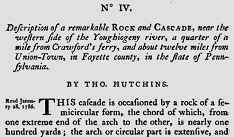 |
| 1786 article about the Ohio Pyle falls in the American Philosophical Society Proceedings |
At the time the Minerds settled in the remote mountains, the wooly region was not unknown to the outside world. The Ohio Pyle falls, just five miles away, were well known as a natural wonder featuring whitewater rapids and a semi-circular rock measuring nearly 100 yards from one end of the arch to the other. In fact, in 1786, the American Philosophical Society published a short article by surveyor Thomas Hutchins entitled “Defcription of a Remarkable ROCK and CASCADE, near the weftern fide of the Youghiogeny river, a quarter of a mile from Carwford’s ferry, and about twelve miles from Union-Town, in Fayette county, in the ftate of Pennfylvania.” As he also had written an article in the same publication, Dr. Benjamin Franklin may have had knowledge of the falls. The piece was reprinted in a 1788 article in The European Magazine and London Review and in June 1794 in The New-York Magazine, among other influential journals in the United States and Europe.
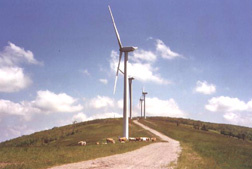 |
| Summit of Jacob's farm, where windmills have been installed in recent years |
The Minerds did not own their large farm of 393 acres. Rather, they apparently rented it from its lawful but absentee owner, a man named Job Nob. Not much is known about Nob except that in January 1794, he received a warrant for 400 acres of land in nearby Bedford County, following a survey of the property. Eleven other men named "Nob" also obtained Bedford County acreage warrants, among them Jacob, Frederick, George, William, David, Samuel, John, Joseph, Solomon, James and Sampson Nob.
At an elevation of 2,900 feet above sea level, the view at the top, on a clear day, would have been spectacular, with vistas visible for many miles in every direction.
After putting down roots in Fayette/Somerset Counties, says a history penned by great-grandson Allen Edward Harbaugh, Jacob "pitched his camp under a large tree until he built a cabin. He labored rearing a home and clearing land.
 |
| 1896 map of original warrantee surveys in Fayette County, showing the precise location of the salt springs where Jacob boiled salt, and where his daughter Martha brought provisions. The site was bisected in about 1871 with a line of the Baltimore & Ohio Railroad. |
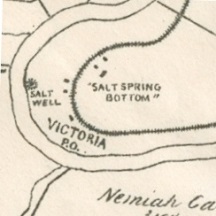 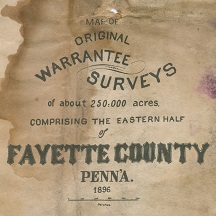 |
Various maps, including the Fayette County tax assessment map, and U.S. Geological Survey map, pinpoint the exact location of their farm. Click here to see these maps in detail. The farm was irregularly shaped like a "U," with the Fayette and Somerset County boundary line running diagonally, from top right to bottom left, along the mountainous right hand edge of the property.
To generate income, Jacob boiled salt in the lowlands of the Victoria valley, about three miles from the falls at Ohio Pyle. While laboring, his young daughter Martha brought provisions to him. Said Ellis' 1882 History of Fayette County:
The manufacture of salt was an industry which once held an important place in the township more than half a century ago. On the north side of the Youghiogheny, three miles above the falls, were several acres of low ground, called by the pioneers "the meadows" where were salt licks, which were much frequented by wild animals. When the water was low the incrustations of sale on the flat stones along the river's edge were so marked that the place presented a whitish appearance. Before 1800 some of the settlers gathered up the waters which oozed forth and made small quantities of salt, and later a man by the name of Rhodes dug a well some twenty feet deep, which gave him a greater supply of water, and enabled him to make salt in a small way. When he suspended work he allowed his kettles to remain, and some of the pioneers would occasionally go there to make a little sale for their own use. As the place was rather inaccessible from the east, on account of the steep hills, the river was usually forded by the people living on the south and the west at a point near the springs. This was always attended by danger, as the current is swift and strong, and when increased by heavy rains is especially treacherous.
President Thomas Jefferson knew of the salt lick locale. In his famous 1787 book, Notes on the State of Virginia, he states that "A salt spring has been lately discovered at the Turkey foot on Yohogany, by which river it is overflowed, except at very low water. Its merit is not yet known." Tim Palmer's book, Youghiogheny: Appalachian River, says that the spring attracted deer, which may have pleased hunters, and that locals "collected the water and boiled it down for salt."
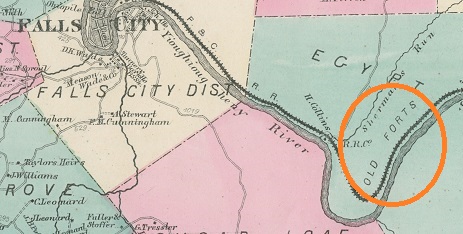 |
Above: The site of the springs near Ohio Pyle/Falls City where Jacob boiled salt held the ruins of native Indian forts as circled. Below: the springs site today. |
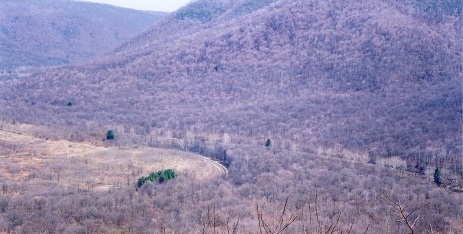 |
The site of the salt springs also contained ruins of Native American forts that Jacob undoubtedly would have explored. These are labeled in an atlas map of Stewart Township published in 1872. In a chapter on the township, Ellis' History of Fayette County says that "Along these streams are many signs of prehistoric occupation, a line of earthworks being traceable all through the township. One of the largest of these forts was... several miles below the Ohio Pile Falls. It was circular in form, inclosed about ten acres, and was surrounded by a trench."
Lower portion
of Jacob's farm, to the left
The mountainous frontier to which Jacob and Maria moved in 1791 also was blessed with rich natural resources -- coal, timber, land and water -- which provided income for generations of descendants. The region also was rich in historical sites, such as Jumonville, where the French and Indian War began in 1754, and Fort Necessity, where young Lt. Col. George Washington was soundly defeated in his first battle as an officer. Later,
Washington helped bury his commander, Maj. Gen. Edward Braddock, who was mortally wounded in battle by the French and Indians at
what is now Braddock, near Pittsburgh, PA. Braddock's grave, along Route 40 at Chalk Hill, PA, is marked by a huge granite stone and is today a national monument.
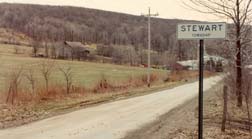
Another famous resident of Fayette County of that era was Albert Gallatin, future Secretary of the Treasury under Presidents Jefferson and Madison. Gallatin resided at Friendship Hill, and as Treasurer helped finance the Louisiana Purchase, and construction of the National Highway (Route 40) which later provided employment for many other Minerd descendants.
Sometime between 1811 and 1815, Jacob died. While Ellis' History of Fayette County tells us that Jacob died 20 years after his settlement (which would thus have been 1811), we have a clue that he may have lived at least until 1814. For one, his name disappears from the Fayette County tax rolls in 1815, and his wife appears as "Widow" in the 1816 lists. Also, the Jan. 4, 1815 Uniontown Genius of Liberty reports that there was an unclaimed letter at the Uniontown post office for "Jacob Mynerd." This suggests he may have died around that time, perhaps in December 1814. The clipping is seen here, the oldest known newspaper reference in our family.
Jacob's name, spelled "Mynerd," 1815
Jacob was buried in what is now the Indian Creek
Baptist Church Cemetery in Mill Run. Maria
is thought to have lived at least until 1820, though her final fate is
unknown. Her name disappears from the county tax rolls after 1819.
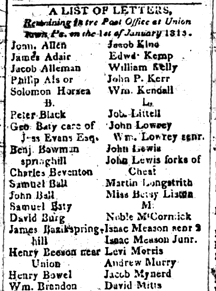
In 1882, a brief biography of Jacob was published in Franklin Ellis' History of Fayette County. This paragraph was excerpted in Velma Byrum Keller's Immel and Imel Families in America. Jacob and Maria, and his brother Friedrich Jr. married to her sister Catherine, are mentioned in a paragraph on her Nein family in Beers' 1909 Historical and Biographical Annals of Berks County, Pennsylvania.
In 1998, the Daughters of the American Revolution acknowledged Jacob's status as a Revolutionary-era patriot for the first time. Click to see a summary of our cousins' pursuit of DAR membership.
In 2002, the U.S. Department of Veterans Affairs furnished a new granite memorial to mark Jacob's approximate gravesite, and on July 13, 2003, the marker was dedicated at the annual Minerd-Miner-Minor Reunion in a special ceremony attended by 40 descendants. Assisting in the ceremony were the DAR's Col. Lynn Chapter of Uniontown and the local Veterans of Foreign Wars and American Legion posts. In recognition, Mayor James Sileo and the Uniontown City Council unanimously issued an official proclamation declaring the two-day affairs as "Jacob Minerd Weekend" in the county seat city. The Uniontown (PA) Herald-Standard published a feature story about the reunion, "90th Reunion Includes Dedication" and opened with this sentence: "If you are one of the 40,000 or more descendants of Jacob Minerd, you probably will be at the 90th anniversary of the first Minerd reunion in Western Pennsylvania on July 12-13."
Jacob and Maria are mentioned in a lavishly illustrated, 2011 book about about their great-grandson Ephraim Miner -- entitled Well At This Time: the Civil War Diaries and Army Convalescence Saga of Farmboy Ephraim Miner. The book, authored by the founder of this website, and the great-great-great-great-great grandson of Jacob and Maria, is seen here. [More]
~ Timeline of Jacob and Maria's Known Activities ~
1766 - Son John Minard born in either Pennsylvania or Frederick County, MD. [Source: Censuses of Harrison County, OH for 1850 and 1860.]
1767 - Taxed in Oley Twp., Berks County, PA. Spelling: Meiner. [Source: Pennsylvania Archives Series]
1771 - May 22 - Named as a defendant in a lawsuit filed at Reading, Berks County. Casper Krisimer charged that Miner and others illegally "felled & cut down" Krisimer's trees that were valued at £50. Miner and others were accused of having "carried away" the timber and wood and converted it "to their own property and use." Spelling: Miner [Source: Berks County civil court]
1774 - Jan. 26 - Son Borckhart [Burket] Minerd born, and later baptized at the Zion-Lehigh Church at Alburtis, Lehigh County, PA. Spelling: Meinert. [Source: Baptismal records of the Zion-Lehigh Church.]
1776 - Son Daniel Miner Sr. born in Pennsylvania. [Source: Census records of Morrow County, OH for 1850.]
|
|
|
|
| Record of Jacob's allegiance
oath, sworn to Jacob Weaver in Berks Co. on May 30, 1777 |
1777 - May 30 - Took an oath of allegiance in Berks County. Spelling: Minor. [Source: The Names of Persons Who Took the Oath of Allegiance in Berks County, Pennsylvania, Book D, Vol. I, on file at the Berks County Historical Society.] Later, was assessed a fine as a member of the Third Class of Capt. Focht's Company in Berks. Spelling: Minor. [Source: State of the Accounts of Jacob Morgan, Senior, Late Lieutenant of Berks County]
1777 - Son Frederick Miner Sr. born in Pennsylvania. [Source: Frederick's grave marker; death certificate of his son Frederick Miner Jr.]
1779 - Oct. 11 - Purchased 5 acres from Abraham and Anna Maria Stein in Hanover Twp., Lancaster County, PA. Was a resident of Exeter Twp., Berks Co., PA, at the time. Spelling: Minert. [Source: Berks County Deed Book 11]
1780 - Son Jacob Minerd Jr. born, presumably in Roscombmanor, Berks County, PA.
1783 - Presumed daughter Christina born on Dec. 19, and baptized by the pastor of the Evangelical Lutheran Church of Frederick, Frederick County on Sept. 27, [1784?] with Martin and Christina Eberhardt serving as sponsors.
1787 - June 11 - Named in the will of father in law, Casper Nein: "...I give and bequeath unto my Daughter Maria Intermarried unto Jacob Meinert the sum of Forty Pounds money as aforesaid Four Years + a half after my decease." The will also bequeathed £40 to "my Daughter Catharina Intermarried unto Fredrick Meinert" to be paid two and a half years after his decease. [Source: Berks County Will]
1789 - March 10 - Daughter Martha (Minerd) Imel Harbaugh born (presumably) in Emmitsburg, Frederick County, MD. [Source: Harbaugh's 1913 Sketch of Minerd Family - Historical and Traditional]
1790 - Listed on the census of Frederick County, MD. Living in his household were 1 male over 16, 3 males under 16, and 5 females. Spelling: Meinhard. [Source: U.S. Census]
1790 - Son Henry Minerd born in Somerset County, PA. Spelling: Minerd. [Source: Biographical and Portrait Cyclopedia of Fayette County, Pa. by Samuel T. Wiley, Chicago, 1889.]
1791 - Settled on the "Fulton Farm" at what is now Maple Summit, straddling the Fayette/Somerset County (PA) border. [Source: History of Fayette County, Pennsylvania. Franklin Ellis, 1882] After settling, he "pitched his camp under a large tree until he built a cabin. He labored rearing a home and clearing land. He also boiled salt at Victoria. [His daughter Martha], while yet a girl carried provisions to him at the Saltspring bottom." [Source: Harbaugh's 1913 Minerd history]
1793 - Listed on the tax rolls of Turkeyfoot Twp., Somerset County, and was assessed 1 shilling. Spelling: Miner. [Source: The Somerset County Outline And Supplement, by John C. Cassady, 1955] Note - Turkeyfoot Twp., Somerset County, abuts what is now Springfield Twp., Fayette County, right at the site of the Minerd farm.
1795 - First listed on the tax rolls of Bullskin Twp., Fayette County, with 300 acres. Spelling: Minor.
1796 - March 1 - Named as next door neighbor of Francis Moriarty in a deed where Moriarty sold 400 acres to Abraham Stauffer in Bullskin (now Springfield) Twp., Fayette County, PA. [Source: Fayette County Deed Book C-2, Pages 792-793]
1796 - Either he or son Jacob Jr. found a "rude pick-ax, stone pots, hatchets with other implements in a cave in the mountain-side, above our modern Egypt." This site was in the steep hills above the town of Victoria, PA along the Youghiogheny River. [Source: Harbaugh's 1913 Minerd history]
1798 - Oct. 1 - In the 1798 Direct Tax for Pennsylvania, was assessed for 1 cabin and 1 cabin barn on a 400-acre tract, and on a 100-acre tract, on Laurel Hill in Saltlick (now Springfield) Twp., Fayette County. The 400-acre tract was owned by John Moriarty, and the 100-acre tract was owned by Matthew Hardford. Spellings: Minard and Minerd. [Source: General List of Lands, Lots and Buildings that Were Owned, Possessed, or Occupied on the First Day of October, 1798 Within the Second Assessment District, Composed of the County of Fayette in the Ninth Division in the State of Pennsylvania]
1800 - Named on the census of Saltlick (now Springfield) Twp., Fayette County. In his household were 1 male under 10, 2 males between 16-26, 1 male over 45, 2 females between 10-16, 1 female between 16-26 and 1 female over 45. Spelling Minard. [Source: U.S. Census]
1800 - Nov. 19 - Mother in law Barbara Nein died in Berks. In her will, written years earlier, she wrote: "I give and bequeath unto my Daughter Maria Miner, [Wife of Jacob Miner] my beft new Bed, Bedftead, Bed clothes & Curtains thereunto belonging." She also willed to her daughters "Wearing Apparel, together with all my Linen & Linsey Woolsey". She also willed them their fair share of £7, 6 shillings and 6 pence divided equally. The will was witnessed by James, Moses and Sarah Boone, uncle and cousins of famed frontiersman Daniel Boone. Spelling: Miner. [Source: Berks County wills]
1801 - Listed in the tax rolls of Saltlick Twp., Fayette County. Also listed is a "John Minor" who was said to have "Moved."
1802 - First taxed on 93 acres of land in Saltlick Twp., Fayette County.
1803 - Listed in the tax rolls of Saltlick Twp., Fayette County. Also listed is "Philip Minor," identity unknown.
1804 - Named as a next-door neighbor of Benjamin (a.k.a. Benoni) Harris in a deed where Harris sold 400 acres of land to Samuel Sisler in Saltlick (now Springfield) Twp., Fayette County. Spelling: Miner.[Source: Fayette County Deed Book G, Pages 35-36] Note - it's conceivable that this same Sisler was the father of Hester Sisler who married Jacob Minerd's son Henry.
1800 - Listed in the tax rolls of Saltlick Twp., Fayette County. Also listed is "Jacob Minor Jr."
 |
| A 3x great grand daughter pays respects at Jacob's grave, 2003 |
1811 - May have died in Springfield Twp. -- "Twenty years after his settlement [in 1791] he died, and was buried in what is now the Baptist graveyard at Mill Run." [Source: Ellis's 1882 History of Fayette County] However, tax records strongly suggest he may have lived as late as 1814.
1812 - Listed in the tax rolls of Saltlick Twp., Fayette County. Also named was "Henry Minor" who was listed as "Single."
1814 - First taxed for 393 acres of seated lands in Saltlick (now Springfield) Twp., Fayette County. Assessed as a farmer with 1 horse, 3 cattle, 1 dog. Also was assessed for 225 acres of unseated lands with the tax "Paid to J. Roberts on the 4th October 1814 together with Jacob Immel's tax." Spelling: Minard. [Source: Fayette County Tax Assessors Records]
1815 - Name does not appear in tax assessment records of Fayette County. "Henry Miner" is listed as a farmer with 300 acres with the "Land transferred from William Hardy" (or Handy).
1815 - Jan. 4 - Listed in a Fayette County newspaper among recipients of mail whose letters were sitting undelivered in the post office at Uniontown. This also suggests he may have recently died. Spelling: Mynerd. [Source: Uniontown Genius of Liberty]
1816 - Wife "Margaret," listed as "Widow," was assessed for 1 cattle, 1 dog and 300 acres of seated lands in Saltlick (now Springfield) Twp., Fayette County. "Henry Miner" also is listed, with an occupation of "Labor." Spelling: Miner. [Source: Fayette County Tax Assessors Records]
1819 - Widow "Mary" is listed in the tax rolls of Saltlick Twp., Fayette County. Also listed is "Henry Miner", with 300 acres.
1820 - For the first time, widow Mary's name does not appear on the tax rolls of Saltlick Twp., Fayette County. Son "Henry Miner" is listed with 300 acres, and his occupation given as "Farm."
1823 - "Henry Miner" is taxed for 93 acres in Saltlick Twp., Fayette County, appearing to possess the tract Jacob had occupied starting in 1802.
1882 - Described in a paragraph in Franklin Ellis' monumental work, History of Fayette County, Pennsylvania. See above.
|
|
|
Jacob &
Maria named in a |
1909 - Named in the Historical and Biographical Annals of Berks County, Pennsylvania (Chicago, J.H. Beers & Co.) in a chapter on David D. Nein. Jacob's brother Friedrich Jr., who was married to Maria's sister Catherine, also are mentioned in the volume. Spelling: Miner.
1913 - Aug. 8 - Described in Sketch of Minerd Families Historical and Traditional written by great-grandson Allen Edward Harbaugh of Mill Run, Pa., and read aloud at the Minerds' first Annual Reunion.
1990s - Acknowledged for the very first time by the Daughters of the American Revolution as a Revolutionary War militia veteran.
2001 - Honored as the featured theme at our National Minerd-Miner-Minor Reunion, including with a visit to the Indian Creek Baptist Church Cemetery in Mill Run, PA, where he is said to be buried.
2001 - The Steyer family, current owners of the Minerd farm, leased the ridgeline to Mill Run Windpower, which in turn erected a series of large windmills. According to a feature article in the Pittsburgh Tribune-Review, each windmill towers 210 feet in height, and the blades themselves measure 100 feet in length. The mills are a renewable energy resource for thousands of homes in the region.
2002 - Acknowledged for the very first time by the federal government (U.S. Department of Veterans Affairs) as a Revolutionary War militia veteran with the issuance of a new granite standard-issue military grave marker.
|
Jacob & Maria named in a book about their great grandson |
2003 - On July 13, 2003, Jacob's marker is dedicated at the annual Minerd-Miner-Minor Reunion in a special ceremony attended by 40 descendants. Assisting in the ceremony were the DAR's Col. Lynn Chapter of Uniontown and the local Veterans of Foreign Wars and American Legion posts. In recognition, Mayor James Sileo and the Uniontown City Council unanimously issued an official proclamation declaring the two-day affairs as "Jacob Minerd Weekend" in the county seat city. The Uniontown (PA) Herald-Standard published a feature story about the reunion, "90th Reunion Includes Dedication" and opened with this sentence: "If you are one of the 40,000 or more descendants of Jacob Minerd, you probably will be at the 90th anniversary of the first Minerd reunion in Western Pennsylvania on July 12-13."
2008 - Jacob and Maria are mentioned in a special commemorative "Pittsburgh 250" edition of Pittsburgh Quarterly magazine, in an article headlined "Family Is Everything -- and for Mark Miner, Cousins Are Everywhere," authored by Minerd.com founder Mark A. Miner. Click for a PDF reprint (1MB in size).
2008 - June 27-29 - The Minerd-Minard-Miner-Minor family's annual national reunion in Pittsburgh, to help the city celebrate its 250th birthday, is covered with feature stories mentioning Jacob and Maria in the Pittsburgh Post-Gazette and Pittsburgh Tribune-Review. The Post-Gazette article is headlined "Getting to Know You," and the Tribune-Review's is "Clan's Reunion to Draw from Across the Country."
2011 - Mentioned in Well At This Time: the Civil War Diaries and Army Convalescence Saga of Farmboy Ephraim Miner, authored by the founder of this website. On June 13, 2011, Jacob and Maria were mentioned in major feature article, "Reunion to Trace Minerd Family's Rich Role in History," in the Pittsburgh Tribune-Review.
|
Copyright © 1998, 2000, 2003, 2005, 2011-2012, 2015, 2017, 2020-2021, 2025 Mark A. Miner |
|
Windmill and grave visitor photos by Sharon (Sheldon) Kern |
